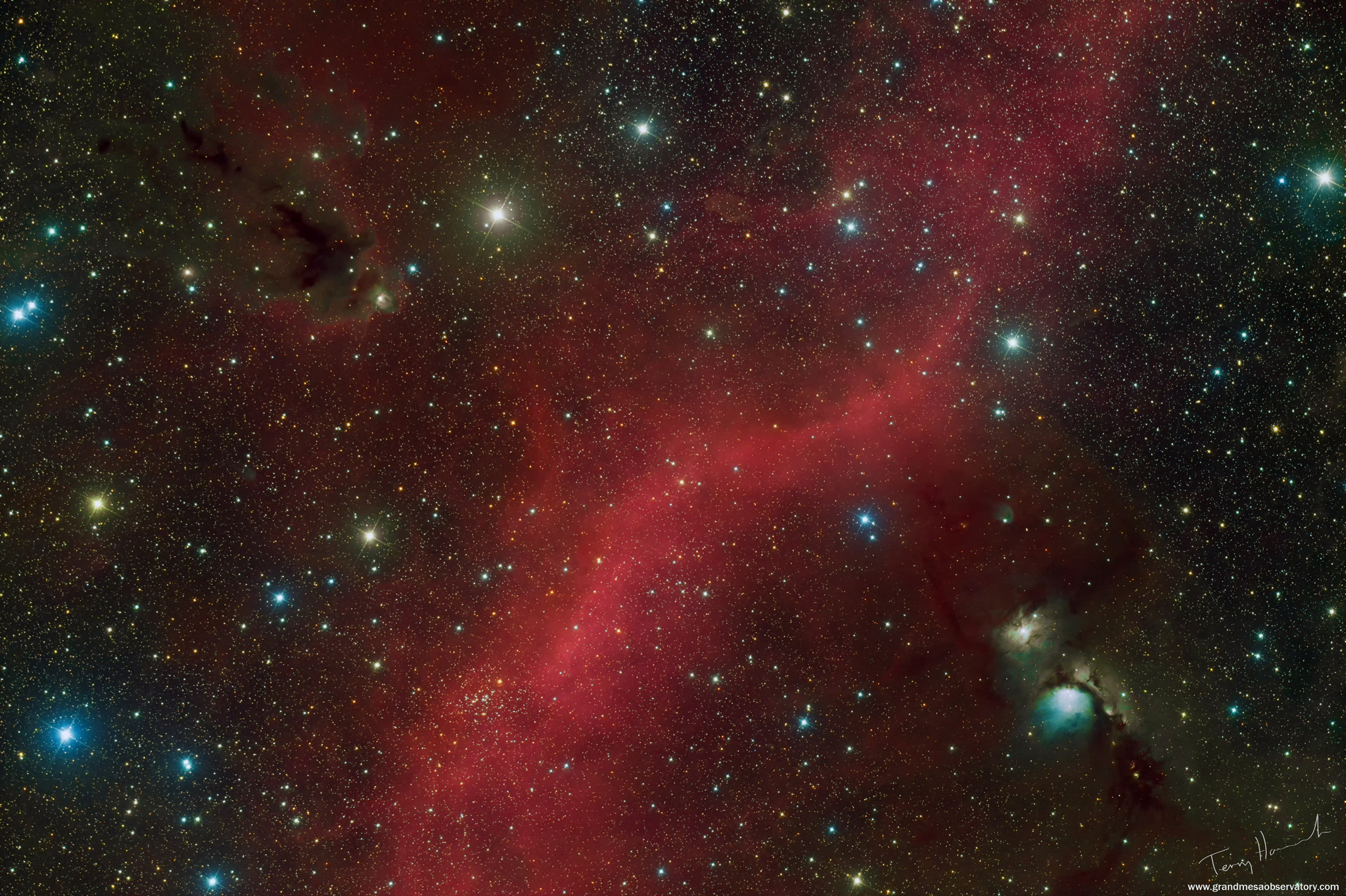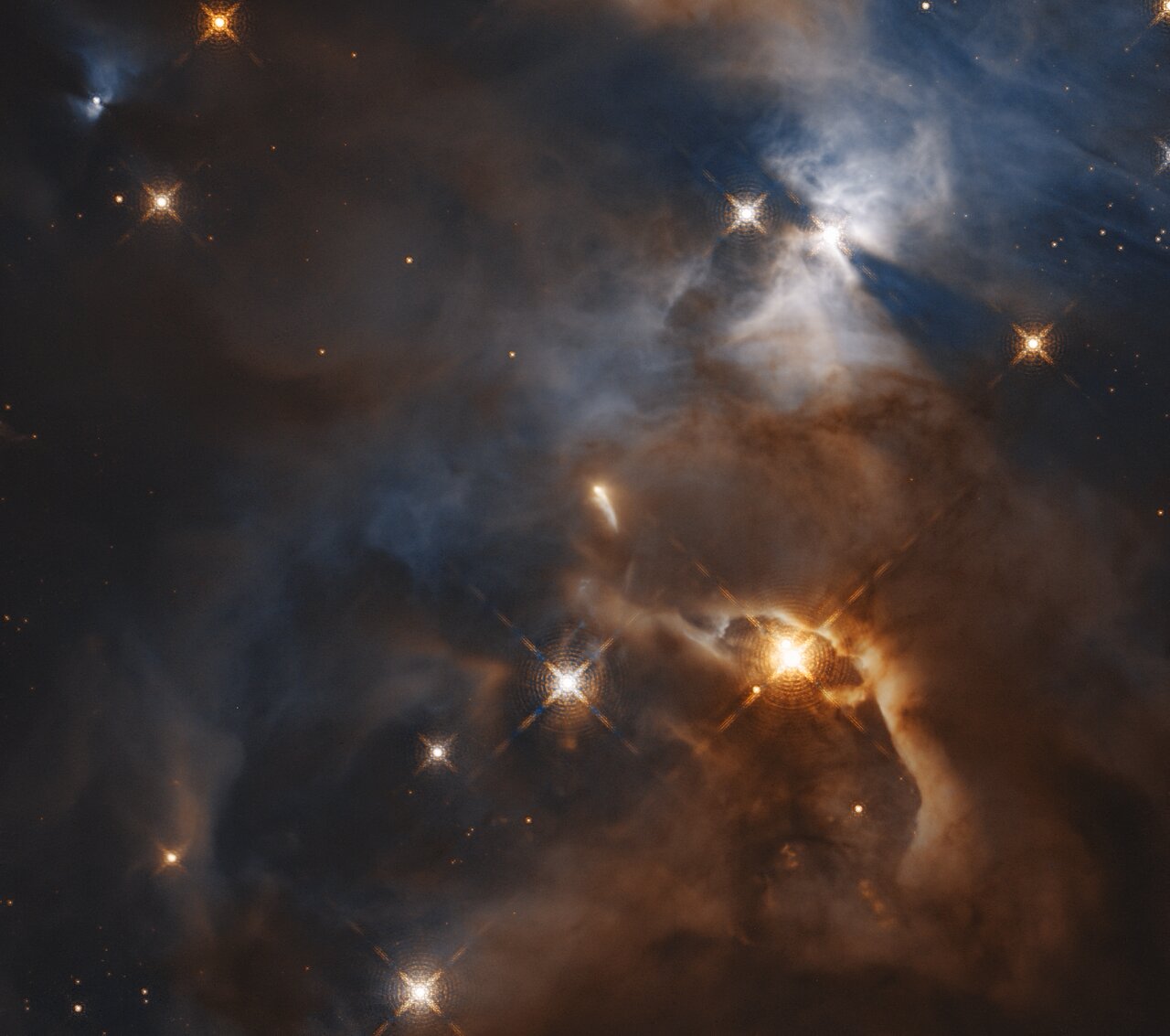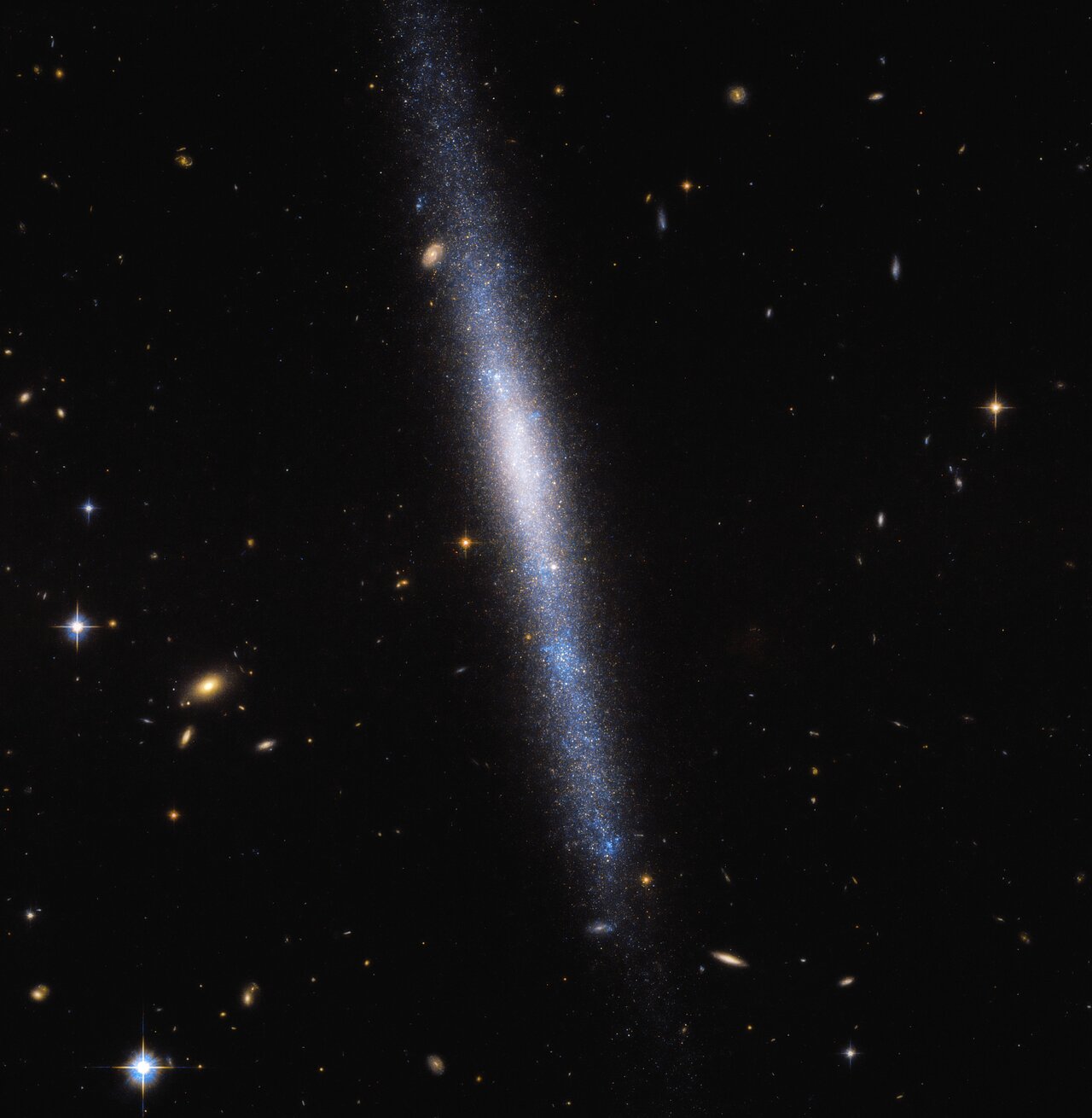Blog
Bright stars, interstellar clouds of dust and glowing nebulae fill this cosmic scene, a skyscape just north of Orion’s belt. Close to the plane of our Milky Way Galaxy, the wide field view spans just under 5 degrees or about 10 full moons on the sky. Striking bluish M78, a reflection nebula, is at the lower right. M78’s tint is due to dust preferentially reflecting the blue light of hot, young stars. In colorful contrast, the red swath of glowing hydrogen gas streaming through the center is part of the region’s faint but extensive emission nebula known as Barnard’s Loop. At upper left, a dark dust cloud forms a prominent silhouette cataloged as LDN 1622. While M78 and the complex Barnard’s Loop are some 1,500 light-years away, LDN 1622 is likely to be much closer, only about 500 light-years distant from our fair planet Earth.

Neil Cowley (born 5 November 1972) is an English jazz pianist and composer. He has also released music as part of Fragile State, the Green Nuns of the Revolution, and the Neil Cowley Trio. With his trio, he appeared on Later… with Jools Holland in April 2008 and won the 2007 BBC Jazz Award for best album for Displaced.. In 2018, Cowley announced he was working on a new electronic focused solo project.
more...Arthur Ira Garfunkel (born November 5, 1941) is an American singer, poet, and actor. He is best known for his partnership with Paul Simon in the folk rock duo Simon & Garfunkel.
Highlights of his solo music career include a top 10 hit, three top 20 hits, six top 40 hits, 14 Adult Contemporary top 30 singles, five Adult Contemporary number ones, two UK number ones and a People’s Choice Award. Through his solo and collaborative work, Garfunkel has earned eight Grammys, including a Lifetime Achievement Award. In 1990, he and Simon were inducted into the Rock and Roll Hall of Fame. In 2008, Garfunkel was ranked 86th in Rolling Stone magazine’s list of the 100 Greatest Singers of All Time.
Garfunkel was born in Forest Hills, Queens, New York City, the son of Rose (née Pearlman) and Jacob “Jack” Garfunkel, a travelling salesman. He was a middle child with two brothers, the older Jules and the younger Jerome. Jacob’s parents immigrated to the United States at the turn of the century, and settled in Manhattan. Before his career in sales, Jacob worked as an actor in Dayton, Ohio. Garfunkel is of Romanian Jewish descent, his paternal grandparents having emigrated from the city of Iași. When he was young, he would often sing in synagogue. His maternal cousin was Lou Pearlman, founder of the Backstreet Boys and NSYNC.
more...Jazz bassist, born November 5, 1921 in Social Circle, Georgia. Wootten started his career playing country & western, moved to big band jazz, then back to country and won an Academy of Country Music Award as Best Bassist in 1982. While still in his teens, Woottenlanded a six-dollar-a-week gig on Archie “Grandpappy” Campbell‘s C&W show on radio station WDOD in Chattanooga, TN; the band included future Sons of the Pioneers guitarist Roy Lanham. Texas crooner Gene Austin hired the band and dubbed them the Whippoorwills. Wootten toured with Austin for a time, then quit the band due to exhaustion. Wootten went on to play with several successful big bands of the ’40s, including those led by Jan Savitt and Tony Pastor. Beginning in 1949, he played with a succession of prominent swing bandleaders, including Tommy Dorsey, Woody Herman, and Charlie Barnet. In 1957, he recorded with Harry Babasin‘s Jazzpickers in a rhythm section that also included Red Norvo. He hooked up with Norvo and recorded and toured with the vibist in 1957-1958. Wootten recorded The Most Exciting Guitar with Lanham in 1959. That year, Wootten also toured with Benny Goodman and Frank Sinatra. With Sinatra, Wootten did movies, TV, and worked the Sands Hotel in Las Vegas. In the ’60s and ’70s, Wootten worked mostly in the studios; he also composed and arranged for film and authored a book of musical exercises for bass instruments. In addition to the aforementioned, Wootten played with Merle Travis, Glen Campbell, Eddie Dean, Mary Ford, Tex Williams, Jimmy Bryant, Joe Maphis, and Roy Rogers, among many others. He also worked on Gene Autry‘s Melody Ranch radio show.
more...The young star HBC 672 is known by its nickname of Bat Shadow because of its wing-like shadow feature. The NASA/ESA Hubble Space Telescope has now observed a curious “flapping” motion in the shadow of the star’s disc for the first time. The star resides in a stellar nursery called the Serpens Nebula, about 1300 light-years away.
The Hubble Space Telescope captured a striking observation of the fledgling star’s unseen, planet-forming disc in 2018. This disc casts a huge shadow across a more distant cloud in a star-forming region — like a fly wandering into the beam of a flashlight shining on a wall.

Jerome Najee Rasheed (born November 4, 1957, New York City), known professionally as Najee, is an American Jazz-Smooth Jazz saxophonist and flautist.
Najee was born in the lower west side of Manhattan in New York City and lived his teenage years in Queens, New York. His father died at a young age, and Najee and siblings were raised by his mother Mary Richards. His mother was an important figure and supporter throughout his life and musical career.
Najee’s musical pursuits began in grade school at age eight, where he began playing the clarinet, but he had a deep desire to play saxophone. He was influenced at this age by listening to his mother’s recordings of Miles Davis and other legendary American jazz artists. A pivotal moment in his life began when he made the decision to become a professional jazz musician. In high school, Najee began to study jazz as a student at the Jazzmobile program (co-founded by Dr. Billy Taylor) where he honed his skills on tenor saxophone and flute under the direction of Jimmy Heath, Frank Foster and Ernie Wilkins. At age 16, Najee studied flute at the Manhattan School of Music Preparatory Division, where he took lessons with Harold Jones, flautist from the New York Philharmonic Orchestra.
more...Lawrence Benjamin Bunker (November 4, 1928 – March 8, 2005) was an American jazz drummer, vibraphonist, and percussionist. A member of the Bill Evans Trio in the mid-1960s, he also played timpani with the Los Angeles Philharmonic orchestra.
Born in Long Beach, California, Bunker was a central figure on the West Coast jazz scene, one of the relatively few who actually were from the region. In the 1950s and 1960s he appeared at Howard Rumsey‘s Lighthouse in Hermosa Beach, and performed with Shorty Rogers and His Giants and others. At first he played primarily drums, but increasingly he focused on vibraphone and was later highly regarded for his playing of timpani and various percussion instruments.
A dependable and in-demand studio drummer and vibist, Bunker achieved particular distinction by recording with Billie Holiday, Ella Fitzgerald, Peggy Lee, Diana Krall, and many other jazz greats. In 1952, he was the drummer in one of Art Pepper‘s first groups. In 1953 and 1954, Bunker played drums in some of the earliest of Gerry Mulligan‘s groups. From 1963 to 1965, he was, intermittently, the drummer in the Bill Evans trio. His work in movie soundtracks spanned over fifty years, from Stalag 17 (1953) and Glengarry Glen Ross (1992) to The Incredibles (2004), and included soundtracks by John Williams, Henry Mancini, Quincy Jones, Miklós Rózsa, Jerry Goldsmith, Johnny Mandel, Lalo Schifrin and many other composers.
more...Carlos Valdés Galán (November 4, 1926 – December 4, 2007), better known as Patato, was a Cuban conga player. In 1954, he emigrated from La Habana to New York City where he continued his prolific career as a sideman for several jazz and Latin music ensembles, and occasionally as a bandleader. He contributed to the development of the tunable conga drum which revolutionized the use of the instrument in the US. His experimental descarga albums recorded for Latin Percussion are considered the counterpart to the commercial salsa boom of the 1970s. Tito Puente once called him “the greatest conguero alive today”.
Like most Cuban musicians, Carlos Valdés had several nicknames throughout his artistic career. Early on he was known as “El Toro” (The Bull) as a young dancer and boxer. In school he was known as “Patato” (Potato) due to his short stature; more disrespectfully he was known as “Remache” and “Tampón de bañera” around his neighbourhood. While playing alongside Armando Peraza in Havana’s Zombie Club, he was known as “El Zombie”, “Zombito” or “Pequeño Zombie” (Little Zombie). Due to his dancing style he was known as “Pingüino” (Penguin). Nonetheless, “Patato” was the name that stuck and he carried this pseudonym to the US, where he was often miscredited as “Potato Valdez”.
more...https://www.youtube.com/watch?v=bHOWVSCleG0&list=PLEB3LPVcGcWZ0hsQ5_jgSMhawAnDzy1io&index=29
more...The galaxy UGCA 193, seen here by the NASA/ESA Hubble Space Telescope, is a galaxy in the constellation of Sextans (The Sextant). Looking rather like a waterfall, UGCA 193 appears to host many young stars, especially in its lower portion, creating a striking blue haze and the sense that the stars are falling from “above”.
The blue colour of UGCA 193 indicates the stars that we see are hot — some with temperatures exceeding 6 times that of our Sun. We know that cooler stars appear to our eyes more red, and hotter stars appear more blue. As the mass and surface temperature of a star, and therefore its colour, are linked, heavier stars are able to “burn” at higher temperatures resulting in a blue glow from their surface.

Joe McPhee (born November 3, 1939) is an American jazz multi-instrumentalist born in Miami, Florida, a player of tenor, alto, and soprano saxophone, the trumpet, flugelhorn and valve trombone. McPhee grew up in Poughkeepsie, New York, and is most notable for his free jazz work done from the late 1960s to the present day.
McPhee was born in Miami, Florida, on November 3, 1939. He began playing trumpet when he was eight, before learning other instruments. He played in various high school and then military bands before starting his recording career. His first recording came in 1967, when he appeared on the Clifford Thornton album entitled Freedom and Unity. McPhee taught himself saxophone at the age of 32 after experiencing the music of John Coltrane, Albert Ayler, and Ornette Coleman. During the late 1960s and early 1970s, McPhee lectured on jazz music at Vassar College.
more...Henry Grimes (November 3, 1935 – April 15, 2020) was an American jazz double bassist and violinist.
After more than a decade of activity and performance, notably as a leading bassist in free jazz, Grimes completely disappeared from the music scene by 1970. Grimes was often presumed to have died, but he was discovered in 2002 and returned to performing.
Henry Alonzo Grimes was born in Philadelphia, to parents who both had been musicians in their youth. He took up the violin at the age of 12, then began playing tuba, English horn, percussion, finally switching to the double bass at Mastbaum Technical High School. He furthered his musical studies at Juilliard and established a reputation as a versatile bassist by the mid-1950s. He recorded or performed with saxophonists Gerry Mulligan, Sonny Rollins, pianist Thelonious Monk, singer Anita O’Day, clarinetist Benny Goodman and many others. At a time when bassist Charles Mingus was experimenting with a second bass player in his band, Grimes was the person he selected for the job. One of his earliest appearances on film is captured in the Bert Stern documentary on the Newport Jazz Festival of 1958, Jazz on a Summer’s Day. Grimes was 22 years old, and as word spread among the musicians about his extraordinary playing, he ended up playing with six different groups in the festival that weekend: those of Benny Goodman, Lee Konitz, Thelonious Monk, Gerry Mulligan, Sonny Rollins, and Tony Scott. And though Henry’s name never even appeared in the festival’s printed program, New York Times critic Bosley Crowther took note of the remarkable young bassist and listed him as one of the festival’s primary players.
more...More Posts
- Jerry Garcia Day
- The Cosmos with M66
- Robert Cray Day
- Jerry Garcia Day
- World Music with Mai Tuyet Hoa
- Daily Roots with Horace Andy, Rod Taylor, Earl Sixteen
- The Cosmos with Melotte 15
- Stanley Jordan Day
- Kenny Burrell Day
- Hank Jones Day
- World Music with John Dowland
- Daily Roots with Rod Taylor
- The Cosmos with NGC 3368
- David Sanborn Day
- Buddy Guy Day
- Vernell Fournier Day
- World Music with Fakhriddin Umarov
- Daily Roots with URoy
- BEAU KOO JACKS @ Palmers Sunday July 29th 2018
- The Cosmos with VDB 31
